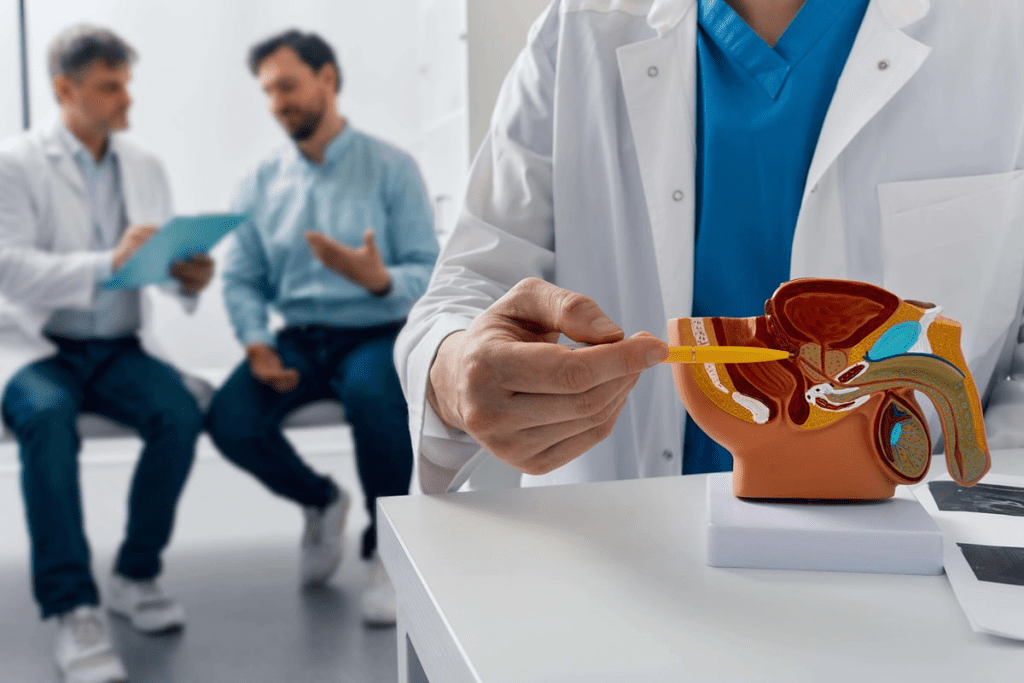Last Updated on November 25, 2025 by

Men with prostate cancer often worry about life without their prostate after surgery. But, thanks to new medical tech and care, many men can live well after the surgery. At Liv Hospital, we’ve seen great results, with a 5-year survival rate of 95.8% and a 10-year rate of 84.8%. Can a man live without his prostate removal? Yes. This guide details the functional changes and high quality of life achievable post-surgery.
Prostate cancer survival rates are even better, at 99.7% at 5 years and 98.7% at 10 years.
Though the idea of losing your prostate might seem scary, it can cure prostate cancer and boost survival chances. Knowing what life without a prostate means is key to making smart health choices.
The prostate gland is key to the male reproductive system. It makes seminal fluid, which is vital for sperm health. Located below the bladder, it’s about the size of a walnut.

The prostate gland is essential for men’s reproductive health. It produces seminal fluids that nourish and protect sperm. The health of the prostate gland is vital for men’s reproductive well-being.
As men get older, the prostate gland can cause health issues. These issues might require removing the gland. Knowing about the prostate’s role and its problems is key to making health choices.
The prostate gland has important roles. It makes a lot of the fluid in semen, which is vital for sperm health. This fluid gives nutrients and protection to sperm, helping them fertilize an egg. The prostate’s secretions also help neutralize vaginal acidity, making it better for sperm.
For more info on the prostate’s functions and its role in male health.
Several conditions can make prostate removal necessary. Prostate cancer is a big concern, where removing the prostate is a common treatment. Benign Prostatic Hyperplasia (BPH), where the prostate grows too big, might also need surgery if other treatments don’t work.
It’s important for men facing prostate removal surgery to understand these conditions. Talking to a healthcare provider about the risks of removing the prostate gland is a must. This helps make informed decisions.
Understanding prostate removal surgery is key for men with prostate cancer or issues. Radical prostatectomy removes the prostate gland. It’s a big step that needs careful thought and planning.

In a radical prostatectomy, the surgeon takes out the prostate gland and nearby tissue. This surgery treats prostate cancer and severe prostatitis. The aim is to get rid of the bad tissue while keeping healthy tissue.
The surgery can be done in different ways:
The type of prostatectomy depends on the cancer stage, the patient’s health, and the surgeon’s skill. Robotic prostatectomy is popular for its precision and fewer complications. But, the right choice is made for each patient.
Preparing for prostate surgery includes several steps:
At Liv Hospital, we focus on personalized care and preparation. Our team helps patients through every step, from preparation to recovery.
Survival rates after prostatectomy are very good, thanks to early detection and treatment. Studies show a high 5-year survival rate for men who have radical prostatectomy. This shows how effective modern medicine is in treating prostate cancer.
Having prostate surgery can change a man’s life. While some face challenges, many see their quality of life improve. Our team is dedicated to supporting patients through recovery.
Living without a prostate means big changes, but knowing the side effects helps. After surgery, men face many changes that can affect their life quality. We’ll look at the recovery, physical changes, and emotional adjustments after prostate removal.
The recovery after prostate surgery is key for long-term health. Right after surgery, men might feel pain, discomfort, and trouble urinating. “The first few days in the hospital are critical,” doctors say, to watch for any problems.
Managing pain is a top priority, with medicine to help. At home, following doctor’s orders is important. This includes rest, wound care, and follow-up visits. Slowly, men can get back to normal, but avoiding heavy lifting is important.
Men may face lasting physical changes after surgery. A common issue is erectile dysfunction. The extent can vary, and treatments like medicine and devices are available. For more on this, Healthline offers helpful information.
Urinary incontinence is another possible long-term change. While it can be temporary, some men may face ongoing issues. Kegel exercises can help control urination and reduce incontinence risk.
Emotional changes after prostate removal are as important as physical ones. Men might feel a mix of relief and anxiety about the future. “Many men feel a sense of loss or grief,” a study found, affecting their identity and masculinity.
Support from doctors, family, and groups is key. Talking openly about feelings helps men adjust and live a fulfilling life.
Men can live fulfilling lives after having their prostate removed. The right care and support are key. Removing the prostate gland does not shorten life expectancy. In fact, for men with localized prostate cancer, it can improve survival rates.
At Liv Hospital, we aim to provide top-notch care to our patients. We ensure they get the best results after prostate surgery. Knowing about the side effects and adjusting to life without a prostate greatly improves a man’s quality of life.
With the right guidance, men can do well after TURP surgery or other prostate removals. We’re here to support our patients every step of the way. Our goal is to help them recover smoothly and live longer, healthier lives after surgery.
Yes, men can live healthy lives without a prostate. The prostate gland is important, but removing it is sometimes needed. This is due to conditions like prostate cancer or BPH.
At Liv Hospital, we’ve seen great survival rates after prostate removal. The 5-year survival rate is 95.8%, and at 10 years, it’s 84.8%. Survival rates for prostate cancer are even better, with 99.7% at 5 years and 98.7% at 10 years.
Life without a prostate can mean dealing with urinary incontinence and erectile dysfunction. But, with the right support, men can manage these changes well.
Radical prostatectomy is a complex surgery. But, thanks to medical advancements, like robotic prostatectomy, recovery is smoother.
Yes, the prostate gland can be removed through radical prostatectomy. This surgery is often needed for prostate cancer and other conditions.
During surgery, the prostate gland is removed carefully. The surrounding tissues are preserved as much as possible. The procedure can be open or robotic prostatectomy.
Recovery starts with a hospital stay, followed by rest at home. It can take weeks to months to fully recover.
Men may face long-term changes, like urinary incontinence and erectile dysfunction. But, with the right care, many manage these side effects well.
At Liv Hospital, we offer full care to help men with prostate removal side effects. Our team supports patients through their recovery.
Subscribe to our e-newsletter to stay informed about the latest innovations in the world of health and exclusive offers!